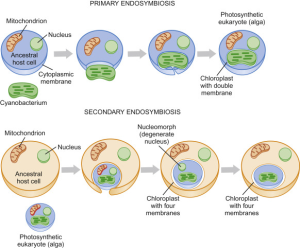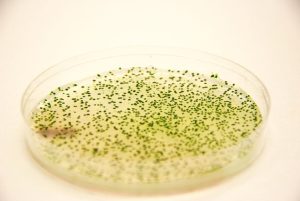Understanding Artificial Endosymbiosis
Written by: Claudia Kowal
Endosymbiosis was discovered in the 1960s by microbiologist Lynn Margulis, who was trying to better understand the evolutionary gap between prokaryotes and eukaryotes. The main distinguishing feature between these cells is that unlike eukaryotes, prokaryotes lack the presence of a nucleus.. By studying the structure of cells, Margulis discovered that the original organelles present within eukaryotic cells originally evolved from free-living prokaryotes- or single-celled bacteria. Uncanny similarities between the organelles and prokaryotic cells, such as physical structure and genetic make-up, supports this theory (University of California-Berkeley, 2021). Essentially, larger prokaryotes could ‘swallow’ smaller ones to form a symbiotic relationship in which the smaller prokaryote would serve as an organelle, and the larger prokaryote would provide protection. An example of this theory is seen in the adaptation of cyanobacteria into chloroplasts. Cyanobacteria, as free-living photosynthetic bacteria, can be ‘swallowed’ by a larger prokaryotic bacteria. By producing energy for the prokaryote to survive, the cyanobacteria consequently becomes a chloroplast for the larger bacteria, making it photosynthetic. After reproducing and collecting generations of organelles, scientists believe that many prokaryotes have evolved into what we consider eukaryotes (Martin et al., 2015). However, the endosymbiotic process is not merely a past phenomenon; it still occurs within cells today.
Figure 1.

A diagram of the basic process of endosymbiosis.
Source: Sciencedirect
The Prospect of Artificial Symbiosis
Recently, scientists have entertained the prospect of artificially reproducing endosymbiosis, with many potential applications for evolutionary science and synthetic biology. Experiments similar to these have been done in the past with photosynthetic algae as an endosymbiont and mammalian cells as hosts (Buchsbaum & Buchsbaum, 1934). This research demonstrated that prokaryotes were able to survive within eukaryotic cells, but they were unsuccessful in modeling the process in which the two worked together to form endosymbiotic relationships (Cournoyer et al., 2022).
One experiment done at the University of Illinois Urbana-Champaign constructed an artificial endosymbiotic relationship between Saccharomyces cerevisiae (yeast) and cyanobacteria, which served as chloroplasts to the yeast. The researchers decided to use the Synechococcus elongatus species of cyanobacteria since it is very closely related to chloroplasts while also being genetically manipulatable. While creating many different strains of cyanobacteria, researchers decided to prioritize photosynthesis ability since the chloroplasts’ primary function was to supply energy to cells. Two different strains of cyanobacteria were injected into yeast cultures and left for several hours to allow for the yeast cells to reproduce. Tests were used to determine the success of the symbiotic relationship, with the most striking results including the output of ATP and yeast cell growth. The experiment found that the output of ATP significantly increased when one strain of cyanobacteria was added to the yeast. This observation suggests that the yeast were getting more efficient at producing energy when they could form relationships with cyanobacteria. Additionally, the cell growth of yeast cells with cyanobacteria had a much higher rate compared to yeast cells without cyanobacteria (Cournoyer et al., 2022). While previous experiments just showed that prokaryotic cells were able to survive within eukaryotic cells, this study clearly indicated that a symbiotic relationship between prokaryotic and eukaryotic cells was not only feasible, but also biologically advantageous.
Figure 2. Synechococcus elongatus strain cultured in a petri dish
Synechococcus elongatus strain cultured in a petri dish
Source: UCLA
Potential Applications
The applications of artificial endosymbiosis can vary and apply to many different fields of biology, like evolution, medicine, and biomedical engineering. To start, artificial endosymbiosis is a great demonstration of the endosymbiotic theory in real life, which further helps us understand the evolutionary relationship between prokaryotes and eukaryotes (Cournoyer et al., 2022). Not only that, it also further helps us understand the function and purpose of organelles, which could have broad applications in medicine. With more knowledge as to how organelles such as chloroplasts work, we may be able to engineer them to reach their full potential in terms of growth and use for biomass (Meaney et al., 2020). There has not been much research done for artificial endosymbiosis, but it has a lot of future applications that would be valuable to look into.
References and Sources
Buchsbaum, R., & Buchsbaum, M. (1934). AN ARTIFICIAL SYMBIOSIS. Science, 80(2079), 408–409. https://doi.org/10.1126/science.80.2079.408
Cournoyer, J. E., Altman, S. D., Gao, Y., Wallace, C. L., Zhang, D., Lo, G.-H., Haskin, N. T., & Mehta, A. P. (2022). Engineering artificial photosynthetic life-forms through endosymbiosis. Nature Communications, 13(1), 2254. https://doi.org/10.1038/s41467-022-29961-7
Martin, W. F., Garg, S., & Zimorski, V. (2015). Endosymbiotic theories for eukaryote origin. Philosophical Transactions of the Royal Society B: Biological Sciences, 370(1678), 20140330. https://doi.org/10.1098/rstb.2014.0330
Meaney, R. S., Hamadache, S., Soltysiak, M. P. M., & Karas, B. J. (2020). Designer endosymbionts: Converting free-living bacteria into organelles. Current Opinion in Systems Biology, 24, 41–50. https://doi.org/10.1016/j.coisb.2020.09.008
University of California Berkeley. (2021, May 21). Endosymbiosis: Lynn Margulis – Understanding Evolution. Understanding Evolution. https://evolution.berkeley.edu/the-history-of-evolutionary-thought/1900-to-present/endosymbiosis-lynn-margulis/#:~:text=Margulis%20spent%20much%20of%20the